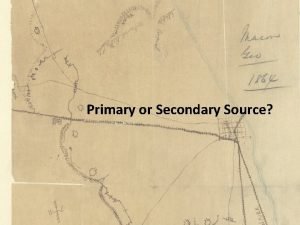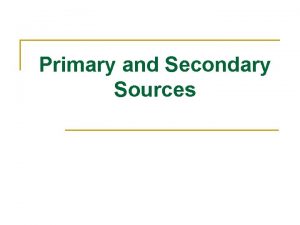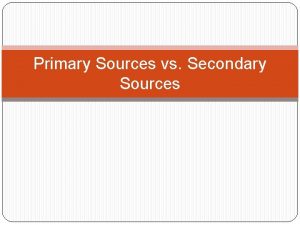Primary and Secondary Sources Primary Source A primary









- Slides: 9

Primary and Secondary Sources

Primary Source �A primary source is a document or physical object which was written or created during the time under study. �These sources were present during an experience or time period and offer an inside view of a particular event.

Types of Primary Sources �Original Documents: Diaries, speeches, manuscripts, letters, interviews, news film footage, autobiographies, official records (like a census) �Sometimes these are translated into English from the original language �Sometimes you only use part (an excerpt) �Creative Works: Poetry, drama, novels, music, art, sculpture �Relics or Artifacts: Pottery, furniture, clothing, buildings

Examples of Primary Sources �Diary of Anne Frank - Experiences of a Jewish family during WWII �The Constitution of Canada - Canadian History �A journal article reporting NEW research or findings �Weavings and pottery - Native American history �Plato's Republic - Women in Ancient Greece �Turn to the person next to you and make a list of three other examples of primary sources

Use of Primary Sources �What are two advantages of using primary sources? �What are two disadvantages of using primary sources?

Secondary Source �A secondary source interprets and analyzes primary sources. �These sources are one or more steps removed from the event. �Secondary sources may have pictures, quotes or graphics of primary sources in them.

Types of Secondary Sources �Publications: Textbooks, magazine articles, histories, criticisms, commentaries, encyclopedias.

Examples of Secondary Sources �A journal/magazine article which interprets or reviews previous findings �A history textbook �A book about the effects of WWI �Turn to the person next to you and make a list of three other examples of secondary sources

Use of Secondary Sources �What are two advantages of using secondary sources? �What are two disadvantages of using secondary sources?
 Tertiary sources
Tertiary sources What is a secondary source
What is a secondary source What are the primary and secondary source of light
What are the primary and secondary source of light Average toe length graph
Average toe length graph What is the primary source of light
What is the primary source of light Print and web sources
Print and web sources Autobiography primary source example
Autobiography primary source example Is an autobiography a primary source
Is an autobiography a primary source Is an illustration a primary or secondary source
Is an illustration a primary or secondary source Why is autobiography a primary source
Why is autobiography a primary source

















